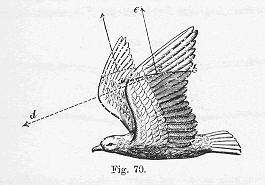(5. Soester Niflungen-Tagung 2000, June, 2. to 4.)
To fly like a bird
The idea of human flight and the history of aviation
By Bernd Lukasch
Numerous authors wrote histories of aviation especially since the birth of the aeroplane. They are all quite similar. Most differentiate on principles of physics between two basic branches: "lighter than air", for example the hot air balloon or the airship, and "heavier than air" including the aeroplane and the helicopter.
The balloon was born in France in 1783 when the first people went up in the hot air balloon of the brothers Montgolfier or the hydrogen balloon of Prof. Charles. The birth of the aeroplane is connected to two remarkable events: the successful gliding flights of the German Otto Lilienthal from 1891 to 1896 and the first flights of the Wright brothers (USA) with their aircraft in 1903. The history of aviation is of course very extensive and so there are numerous amazing pioneer achievements before and after the just described events. The “first” flights are also not undisputed. There are reports about earlier ones, but either their reliability is not certain or they did not influence the development sustainable.
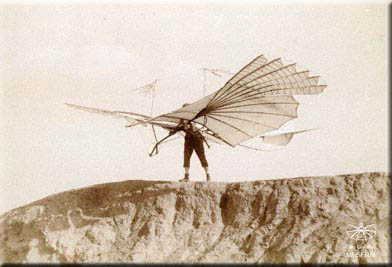
Otto Lilienthal with his "small wing flapping apparatus" in 1894
There are two other reasons why the invention of humans flying takes a special position among the technical pioneer achievements. First, the just described picture of history describes only the technical side of human flight from today's point of view. The kite, the most important forerunner of the aeroplane, is seldom mentioned. With it free flight was not yet possible, (it would be more correct to say flights over certain distances, because the freedom of a balloon ride is similarly limited) but manned takeoffs were certainly possible a several centuries earlier. The wish to travel in the air was not the original idea or impulse of human flight, but to conquer the sky, to leave the surface of the earth and so the earthly vale of tears. Second, the technological history of the aeroplane is connected to a cultural history of the idea of human flight in a way only a few other inventions are. Independent from the technological history the cultural history can be followed up to ancient times and it does certainly not end with the realisation of the aeroplane. In 1999 a song in the charts was called “I dream I can fly”. And the Nobel prize winner for literature Elias Canetti writes “Our dreams like the one to fly are fulfilled and died one after the other. Can you have a new dream?”.
Naturally
questions arise about the background
of unconfirmed records which describe flying apparatuses. What was the
dove of the Greek mathematician Archytas of Tarant (around 400 BC)?
Were the flights of the locksmith Besnier and the “message of
the
flying ship from Portugal at the 24th of June [1709] happily arrived
with its inventor in Vienna” really only hoaxes? How did the
astonishing technical details get into the flight descriptions of
Ikarus, Daedalus or Wieland the Smith?
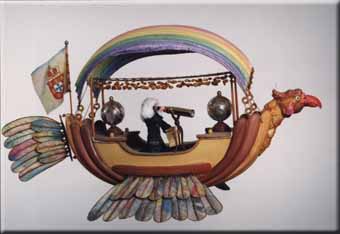
"la Paserola (the great bird)", 1709,
supposedly successfully done project of the Brazilian Portuguese
clergyman Bartholomeo Lourenco de Gusmao. A flying apparatus with
features of an aeroplane and of an airship made of amber, lodestone and
other inventions.
Model done according to historic
drawings: H. Serowski, Otto-Lilienthal-Museum
Following we are going to look closer at two historic events with special concern of Wieland's flights described in the Thidreks legend:
1.
Lilienthal's flights and the technical
prerequisites for his flying apparatus, which presumably made the first
reproducible and secure gliding flights possible
2. The development of the hang glider in the second half of the 20th
century. The hang glider can be considered as the technical minimum
form of a flying apparatus.
Modelled on Bird flight
The oldest known depiction of human flight is dated between 2350 and 2150 BC. The 4cm high clay seal can be seen in the Museum of Ancient Near Eastern Antiquities in the Pergamon Museum in Berlin. It reveals a 10 cm wide clay relief showing the shepherd Etana riding an eagle.
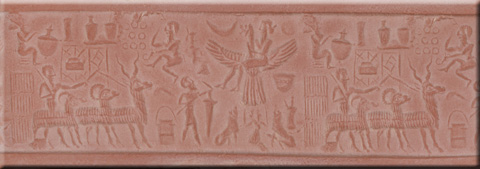
Aviation in sumerian mythology: Clay relief (Museum of Ancient Near Eastern Antiquities in the SMPK Berlin)
Legends, myths and pictures of flying people are not seldom. When did reality mix with these tales? Humans attributed the ability to fly to their deities, mythical figures and demons. The ability of the higher creatures expressed the dream, wish, the trial and the urge of the humans to fly themselves.
It is not a surprise that earlier attempts to fly started work where humans obviously lack bodily prerequisite: The human needs wings. With wings it should be possible to gain the same supremacy in the air as birds and insects. So humans tried over and over again to make their stretched out arms become wings. But what are wings? What is the essential characteristic of the wings of birds that gives them the ability to fly? Lies the secret in the plumage or the bone structure? Or do they even have a special flying organ? Or is the key to be found in the ingenious movements of the wings? They did not know, but the flying of birds seemed to be perfectly natural. There are records testifying to numerous failed attempts or alleged flights.
Nevertheless we should not think that the records are complete or representative. Also it is not possible to clearly separate truth from legend. It is rather a kaleidoscope by chance of the old human dream and of the different projects for its fulfilment. Nearly all attempts are done after the same pattern. The alleged inventor thinks that he has finally found the essential detail that gives the ability to fly to the artificial wings. He climbs a tower or hill. The first flight has to be successful, because there are no safety precautions. Another essential point is that the inventor thinks that he will be able to steer his apparatus straight away. He thinks that no practising is necessary. That seems ridiculous when we consider that an infant needs several month to keep balance under easier and more secure conditions on the surface. None of the inventors considered this problem for the three-dimensional room. To fly meant for them to have working wings, not to learn how to fly.
In the 17th century the first knowledge about the atmosphere was gained and in the closing 18th century the first knowledge on the way to the aeroplane. Before these events history of aviation seemed to be an unsuccessful search on always the same level. Clearly outstanding are the ideas of Leonardo da Vinci. Today it is assumed that these are a summary of the knowledge of his time and that they were also not tested in practical experiments.
Otto Lilienthal
On first glance Lilienthal (1848-1896) was still a birdman, too, a representative of the "Ikarus-Dream". But different to his predecessors he was successful with to his arms attached wings. Several photographs proof this. But not only the proofed knowledge about his success makes Lilienthal different to his predecessors. Lilienthal`s birdlike flying apparatus is not a new, this time successful attempt to copy bird flight. The study of birds flight was for him rather the experimental starting point for a research program which resulted in the man carrying flying apparatus. He moved his research of bird flight from the pure observations of nature to the laboratory. So he could apply his knowledge to the requirements of human flight. His "physics of wing" is in great parts still valid today.
Illustration from Lilienthal's book about bird flight
Lilienthal had a clear interest in the physical basis of flight: He wanted to fly. He realised quickly and correctly that the knowledge of his time was absolutely insufficient for his aim. So he put his main aim aside for decades in order to concentrate on an extensive aerodynamic measurement program. After more than 20 years of experiments in physics without a single practical attempt to fly Lilienthal summarised his knowledge in the book “Bird flight as the basis of aviation” in 1889. Lilienthal describes the technique of flight as a stomping ground for amateurs, “emotion-mechanics” and only a few specialists. His book is for all of them. It is a popular book about physics which guides in a clear line of thought to the from Lilienthal achieved newest state of research. The book is still a standard work for the research of bird flight today. Without an interim or transition the text goes over to a long poem, a message from a stork to man. Lines from the poem serve as inscriptions for Lilienthal memorials at many places.
The book is illustrated by Lilienthal with 80 woodcuts and an watercolour painting showing circling storks. Under the heading “Basis of free flight” Lilienthal gives a popular but absolutely exact introduction into mechanics. Lilienthal fully characterised the problem of the wing with the help of the memorable physical phrase “All flight is based upon producing air pressure, all flight energy consists in overcoming air pressure.” Lilienthal filtered out of the physical knowledge of hydrodynamics and aerodynamics of the 19. century the new questions that concern flight and is therefore the creator of the experimental wing aerodynamics. The discovery of the necessary wing camber is often described as his central achievement. Surely he was the first who clearly inquired into the essence of the artificial wing from the point of physics. The answer is the carved wing. When in 1895 the commemorative speech for the doyen of Berlin physics, Hermann Helmholtz, is held, Lilienthal's measurements are mentioned in connection to the theoretical work of Helmholtz..
"These experiments", Lilienthal writes in the preface of his book, "which covered a period of 23 years, can now be put to a certain end because it was possible to construct a well-rounded line of thought by stringing together the results..." The book ends with "principles on which the artificial flying apparatuses should be made, if the here presented knowledge is true."
Lilienthal combined theoretical and technical skills and skills in craft and athletics in a very special way which enabled him to become the first flying human. He worked out the theoretical stock-in-trade for human flight, constructed a suitable flying apparatus and built it mostly by himself. He had the bodily constitution, courage and dexterity in order to test his flying apparatus. He was constructor and testing pilot in one person. So it was easier for him to improve his construction during the testing period. The diversity of Lilienthal`s skills, the broadness of his interests and his interdisciplinary approach are certainly essential reasons for his success.
Later the brothers Wright called Lilienthal the missionary of human flight. When giving lectures he was so convincing that he captivated his audience. Lilienthal is an exclusive expert of flight technique in his time. The list of his publications is long. Numerous were translated. Lilienthal is a member of the technological commission of the Society for Promoting Aviation and for many years member of the Aeronautical Society of Great Britain. He writes numerous reviews of publications concerning flight technique and has an extensive correspondence with flight technicians from all over the world.
The
brothers Wright started their own
research program in the USA after Lilienthal's death. It was based on
Lilienthal`s work but went clearly beyond it. The program led from the
hang glider to the concept of the aeroplane of our days.
Kite and hang glider
The author and pilot Saint de Exupery described development as the way from the primitive via the complicated to the simple. Considering this definition Lilienthal`s artificial wings would be the primitive and the aeroplane of our days the complicated. Saint de Exupery did not live long enough to see „the simple“: the development of the NASA engineer Francis Melvin Rogallo. It was not, as originally planned, used for the returning from space flights. But the idea of a very simple man carrying wing was successful all around the world since the 1970ies.
Especially interesting for us are the Flexfoil and the original Rogallo wing. They are the minimum form of a man carrying flying apparatus. They are interesting for us for two reasons: First, they allow free human flight requiring a minimum of material and technology – about 10 m² fabric or foil stretched by 4 struts (Rogallo) or by some lines (Flexfoil). Second, because their origins can be seen in the Asian kites, which were already known several thousand years ago. It is not possible to point out a time when this invention would not have been possible.
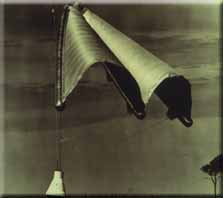
Half stiff Rogallo wing with Gemini space capsule during the testing program (1961-66), picture: NASA
Both modern types of flying apparatuses, the parafoil and the hang glider go back to Rogallo`s (born 1912) developments. He had already developed these basic types of wings after the war and took out a patent on them in 1951. The only user was a toys factory which produced flexible kites for children. In 1960 Wernher v. Braun noticed Rogallo`s work at the Langley-Research Centre in Hampton, Virginia, and made him head of a research program. Kites that unfold in the air were tested with loads of several metric tonnes for space travel. The military was interested in the Rogallo-wing as goods transport self landing glider kite and motorised hang glider. Later the Gemini-Program placed its trust in the „Flexwings“, which was Rogallo`s original idea of a totally flexible wing. But in the end they carried on using the traditional parachute.
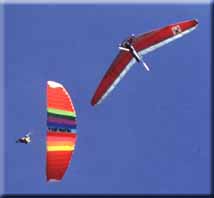
Hang glider and paraglider, the two development directions that arose from the principle of the fully flexible wing
After the development of the space shuttles the work on the flexible wing was discontinued in the course of the Appollo-Program. At the beginning of the 70ies the disappointed Rogallo retired. But Students in California and water-skiing athletes in Australia had studied the no longer secret papers about flexible wings. They used the idea to be pulled by motor boats through the air as captive manned kites. But already In the spring of 1963 an Australian, John Dickenson, built the aircraft that evolved into the modern Hang Gliders built today. Only a few years later his idea became successful in sports all over the world. Above the water it was relatively secure to cut the rope in order to test the kite in free flight. The man carrying hang glider was born.
The new flying apparatus developed
at first slowly but later terrifically. Spectacular flights shown on
funfairs led to an interest of the media and so to a fast spreading.
The flight of the mountain Zugspitze of the American Mike Harker on
April the 11th in 1973 aroused the interest of the media and promoted
the development of the hang glider in Europe. Out of the square canvas
on bamboo spars became a modern flying apparatuses of the 4th
generation. The conventional aeroplane was developed once again. The
hang glider got a steering mechanism and an engine again. After certain
intermediate stages the Ultralight aircraft was developed, which
dominates the motor flight sport today. The aeroplane was born for the
second time, again based on Lilienthal`s hang glider.
When could the first human have flown
The two just described developments are fundamental for determining a certain point in history when the first sincere flight of a human could have been possible.
Lilienthal`s success is based on his method of careful step by step imitation of bird gliding flight. Imitating bird flight was his first aim on his way to human flight. This secure and learnable program was superior to the ones of his predecessors, but also to the „winged steam engines“ of his time and to the drafts of motorplanes that could not be tested in practise. Lilienthal`s flights are often described as the beginning of human flight modelled on the flying of birds. But Lilienthal was successful because he partly overcame this model. Lilienthal succeeded through leaving aside the outstanding qualities of the bird wing - the flapping of the wings and the plumage – and concentrating on the hidden but decisive characteristics of the wing which he determined in laboratory experiments. This was only possible on the basis of 18th century physics with its related scientific methods, but is also a remarkable work of Lilienthal`s personality. An earlier not handed down success using the same method is unthinkable.
The principle of the hang glider is different. The technical related kite was already used thousands of years ago. But the relation to the kite has another aspect too. It is not just possible to study its flight characteristics and to learn how to steer through experiments on oneself, but it is also possible to simulate the flight unmanned and captured. Lilienthal and the brothers Wright used this technique (Their flying apparatuses were called kites but technically their construction was totally different). The Wrights did their tests at the „Outer Banks“ in front of the coast of North Carolina because of the regular strong winds there. Even today hang gliders start by being lifted by the wind for example at the steep coasts of Hawaii. They get carried nearly vertical upwards by simply letting go of (comparable to the cutting of the mooring line).
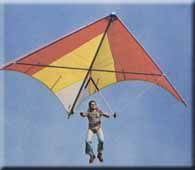
Basic hang glider of the Rogallo type
A third aspect is the relation between parafoil and parachute. The weight of a hang glider lies very low (or is attached to a long rope). That’s why the hang glider does not have the problem of flight stability. A problem that led to Lilienthal`s death and dominates the basic structure of the aeroplane today (dihedral of wings, trimming, tail unit etc.). A kite that has its weight low under the wings, as it is the case with parachutes and parafoils, is as stabile in the air as the seed of the dandelion.
Could it be possible that there is a forgotten early history of free human flight? Is there possibly a forgotten truth about Ikarus, Wieland the Smith or the legend of Alexander? We do not know. But there are good reasons for the following hypothesis: If there really is a forgotten early history of human flight, then the prehistoric flights of human beings were based on the principle of the hang glider, a released kite. But certainly it could not have been an early anticipation of the development of the aeroplane of the 19th and 20th century.

